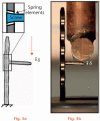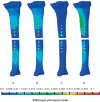Experimental and numerical investigation into the influence of loading conditions in biomechanical testing of locking plate fracture fixation devices
- PMID: 29363522
- PMCID: PMC5805837
- DOI: 10.1302/2046-3758.71.BJR-2017-0074.R2
Experimental and numerical investigation into the influence of loading conditions in biomechanical testing of locking plate fracture fixation devices
Abstract
Objectives: Secondary fracture healing is strongly influenced by the stiffness of the bone-fixator system. Biomechanical tests are extensively used to investigate stiffness and strength of fixation devices. The stiffness values reported in the literature for locked plating, however, vary by three orders of magnitude. The aim of this study was to examine the influence that the method of restraint and load application has on the stiffness produced, the strain distribution within the bone, and the stresses in the implant for locking plate constructs.
Methods: Synthetic composite bones were used to evaluate experimentally the influence of four different methods of loading and restraining specimens, all used in recent previous studies. Two plate types and three screw arrangements were also evaluated for each loading scenario. Computational models were also developed and validated using the experimental tests.
Results: The method of loading was found to affect the gap stiffness strongly (by up to six times) but also the magnitude of the plate stress and the location and magnitude of strains at the bone-screw interface.
Conclusions: This study demonstrates that the method of loading is responsible for much of the difference in reported stiffness values in the literature. It also shows that previous contradictory findings, such as the influence of working length and very large differences in failure loads, can be readily explained by the choice of loading condition.Cite this article:Bone Joint Res 2018;7:111-120.
Keywords: Boundary conditions; Fracture healing; Strain.
© 2018 MacLeod et al.
Conflict of interest statement
Conflicts of Interest Statement: None declared
Figures










Similar articles
-
Biomechanical testing of the LCP--how can stability in locked internal fixators be controlled?Injury. 2003 Nov;34 Suppl 2:B11-9. doi: 10.1016/j.injury.2003.09.021. Injury. 2003. PMID: 14580982
-
Biomechanical comparison of polyaxial-type locking plates and a fixed-angle locking plate for internal fixation of distal femur fractures.J Orthop Trauma. 2009 Oct;23(9):645-52. doi: 10.1097/BOT.0b013e3181a567c8. J Orthop Trauma. 2009. PMID: 19897986
-
Evaluation of a new approach for modelling the screw-bone interface in a locking plate fixation: a corroboration study.Proc Inst Mech Eng H. 2013 Jul;227(7):746-56. doi: 10.1177/0954411913483259. Epub 2013 Apr 4. Proc Inst Mech Eng H. 2013. PMID: 23636756
-
General principles for the clinical use of the LCP.Injury. 2003 Nov;34 Suppl 2:B31-42. doi: 10.1016/j.injury.2003.09.023. Injury. 2003. PMID: 14580984 Review.
-
Pre-operative planning for fracture fixation using locking plates: device configuration and other considerations.Injury. 2018 Jun;49 Suppl 1:S12-S18. doi: 10.1016/S0020-1383(18)30296-1. Injury. 2018. PMID: 29929685 Review.
Cited by
-
Comparison of the Pull-Out Strength between a Novel Micro-Dynamic Pedicle Screw and a Traditional Pedicle Screw in Lumbar Spine.Orthop Surg. 2020 Aug;12(4):1285-1292. doi: 10.1111/os.12742. Epub 2020 Aug 9. Orthop Surg. 2020. PMID: 32776487 Free PMC article.
-
An analytical model of lateral condylar plate working length.Clin Biomech (Bristol). 2023 Dec;110:106129. doi: 10.1016/j.clinbiomech.2023.106129. Epub 2023 Oct 18. Clin Biomech (Bristol). 2023. PMID: 37871506 Free PMC article.
-
Finite Element Analysis of Fracture Fixation.Curr Osteoporos Rep. 2021 Aug;19(4):403-416. doi: 10.1007/s11914-021-00690-y. Epub 2021 Jun 29. Curr Osteoporos Rep. 2021. PMID: 34185266 Free PMC article. Review.
-
Cement augmentation of calcar screws may provide the greatest reduction in predicted screw cut-out risk for proximal humerus plating based on validated parametric computational modelling: Augmenting proximal humerus fracture plating.Bone Joint Res. 2020 Sep 3;9(9):534-542. doi: 10.1302/2046-3758.99.BJR-2020-0053.R1. eCollection 2020 Sep. Bone Joint Res. 2020. PMID: 32922762 Free PMC article.
-
Optimal Design and Biomechanical Analysis of a Biomimetic Lightweight Design Plate for Distal Tibial Fractures: A Finite Element Analysis.Front Bioeng Biotechnol. 2022 Feb 21;10:820921. doi: 10.3389/fbioe.2022.820921. eCollection 2022. Front Bioeng Biotechnol. 2022. PMID: 35265599 Free PMC article.
References
-
- Wagner M. General principles for the clinical use of the LCP. Injury 2003;34(Suppl 2):B31-B42. - PubMed
-
- Kenwright J, Richardson JB, Goodship AE, et al. Effect of controlled axial micromovement on healing of tibial fractures. Lancet 1986;2:1185-1187. - PubMed
-
- Gaston MS, Simpson AH. Inhibition of fracture healing. J Bone Joint Surg [Br] 2007;89-B:1553-1560. - PubMed
-
- Augat P, Burger J, Schorlemmer S, et al. Shear movement at the fracture site delays healing in a diaphyseal fracture model. J Orthop Res 2003;21:1011-1017. - PubMed
-
- Kenwright J, Gardner T. Mechanical influences on tibial fracture healing. Clin Orthop Relat Res 1998;355S(Suppl):S179-S190. - PubMed
LinkOut - more resources
Full Text Sources
Other Literature Sources
Miscellaneous

